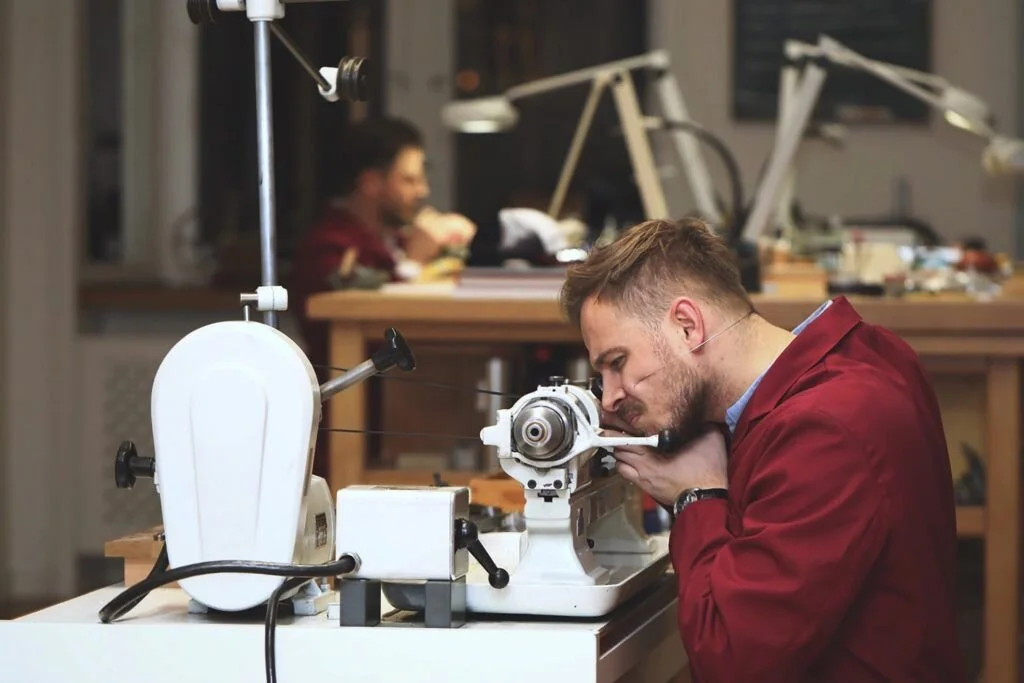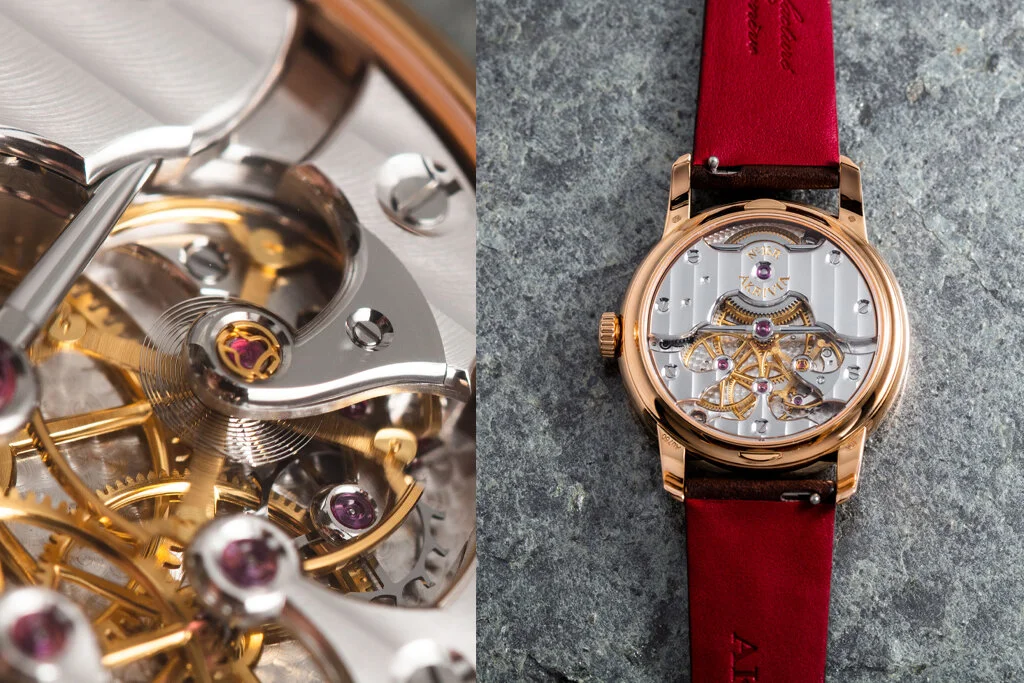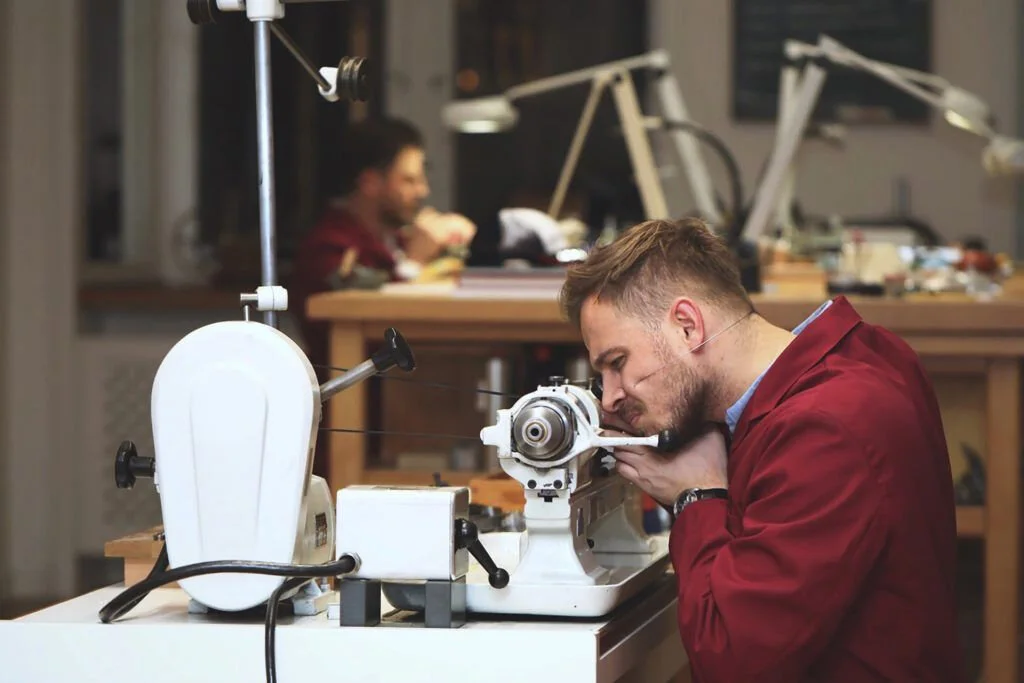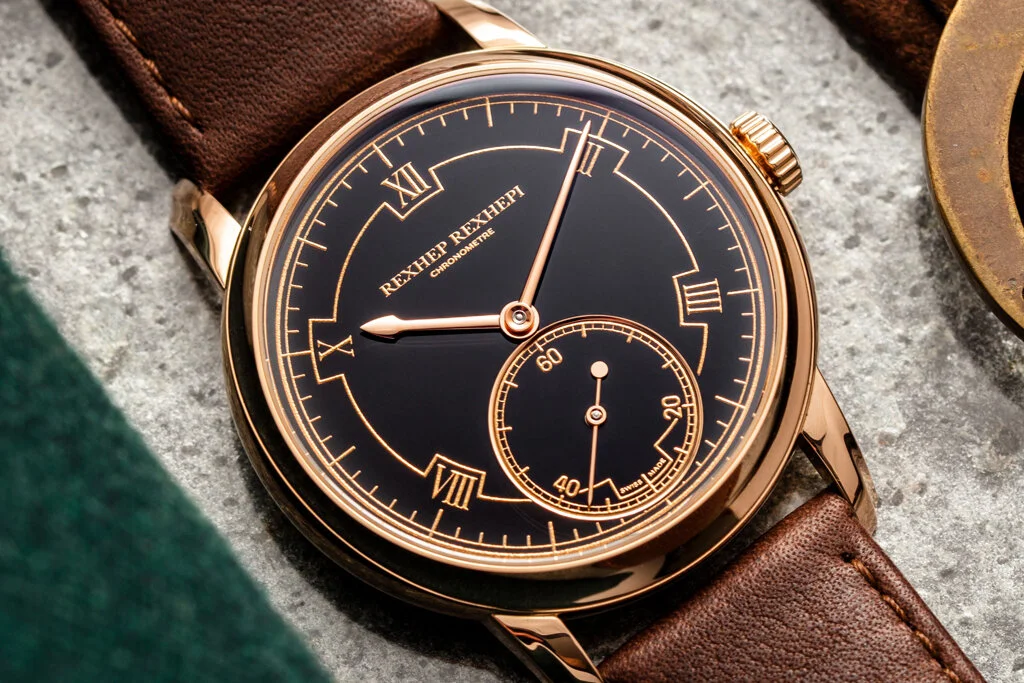Rexhep Rexhepi- How Youth is Ushering In a New Era of Traditional Watchmaking
Question: "If you could only have one good watchmaking tool, and the rest were poor quality, what's your choice for your only good tool?"
Rexhep Rexhepi: "A Schaublin (lathe), for sure. It can be used to make anything."
Rexhepi at work with a Schaublin lathe. (Photo Credit https://swisswatches-magazine.com)
We love asking watchmakers this type of open-ended question. It's in a knee-jerk response where one can begin to see the mechanics of the watchmaker, not the watch. Particularly in this instance, such an answer makes a lot of sense sitting beside Rexhep's greatest watchmaking dream: to build a timepiece completely from scratch. A man who wants to do it all needs a tool that does it all.
On the surface, many readers will already be somewhat familiar with Rexhep's story. As a Kosovar-Albanian, he came to Switzerland at the young age of 12 and went directly into a watchmaking apprenticeship at Patek Philippe. With raw talent and determination, he paved onward to work with F.P. Journe before launching his own brand, AkriviA, in 2012. In the 9 years since its inception, AkriviA has steadily grown a large following of admirers in the global watch community. It's obvious to tie Rexhep's success to the quality of his work. AkriviA's first timepiece, the AK-01 Monopusher Tourbillon, started with a bang and the brand's catalog of timepieces has only continued to meet high expectations.
Akrivia AK-01 Tourbillon Chronographe Monopoussoir
Beneath the surface though, there's more going on with Rexhep and AkriviA than simply great craftsmanship. In order to do the brand justice, we have to talk about youth. In an industry dominated by individuals often 20-30 years his senior, it almost feels a little taboo to speak too directly about youth, as if such a thing doesn't rightfully belong in fine watchmaking! But in his early 30's, Rexhep's youth plays a massive role in his vision, his hunger, flexibility, and what makes him a magnet for watch collectors and enthusiasts.
Rexhep Rexhepi
Youth is about learning fast
Of course, we must first acknowledge that youth comes with its advantages and disadvantages. On one hand, as Rexhep pointed out, youth forces you to learn fast and continuously - it's the only way to catch up with those with many more years of experience. Whether real or imagined, everyone knows the feeling of having to play catch-up with more experienced colleagues and competitors. So how has Rexhep learned so much so fast? What's his approach to bridging the gap between himself and long standing industry veterans?
It's simple. His strategy to gather the knowledge he needs to excel, go directly to the source of knowledge and ask for help. He’s done this with Philippe Dufour, visiting his workshop in the Jura mountains to learn directly from the master on finishing.
The Rexhep Rexhepi Chronometre Contemporain caseback featuring the atelier's hand finishing techniques.
It's pragmatic, and almost sounds too straightforward. Yet, Rexhep remarked that an "ask and you shall receive" approach has been incredibly fruitful during his young career as a watchmaker. It’s in this earnest outreach to the leaders that brought Rexhep his partnership with JP Hagmann, the legendary casemaker who is circa 50 years older than Rexhep. When we spoke, Rexhep remarked that the biggest insights from his time with legends like Dufour and Hagmann have to do with their approaches - broad wisdom that transcends concrete engineering knowledge. For example, Dufour gave him a glance at the craftiness one needs to truly focus on finishing watches beyond the standards of the time. Often, such requires inventing new tools to accomplish jobs no one else even knew existed. Or in the case of Hagmann, J.P. has encouraged Rexhep to feel no pressure to rush toward the future. Learning, patience and continuous improvement go hand in hand, and rushing does little to help.
Rexhep Rexhepi with master casemaker Jean Pierre Hagmann. (Photo Credit AkriviA)
Rexhep's youth isn't only characteristically defined by an earnestness to learn more about watchmaking though. That is only one trait of the watchmaker as an individual. What's truly the most fascinating to us is that Rexhep's allure is in the more substantial cultural shifts playing out slowly from inside of AkriviA. Rexhep at AkriviA isn't only creating wonderful timepieces, he's also prototyping a whole new cultural vibe in fine watchmaking, one that's deeper than trivial generation differences.
Company culture, inside and out
"I've seen Xhevdet (Rexhep's younger brother) on Instagram with Air Max Wotherspoon's and even skateboarding with an AK-06. It's very unusual to see such a thing in the luxury watch landscape."
Rexhep Rexhepi: "Oh yes! People DM us on Instagram and can't believe we skateboard. But that's what our generation does."
Every company is always a reflection of its founder. In this regard, it's not a surprise that all of AkriviA's watchmakers are between the age of 25-39, except, very notably, for JP Hagmann who is now 81. When we spoke with him, Rexhep mentioned that the culture in the workshop is what he's most proud of:
"Most of the culture is composed of excitement for the future. Everyone is growing and evolving so rapidly. Everyone wants to be the best version of themselves. Today, you can't come to AkriviA [as a watchmaker] unless you want to be pushed and grow. It's difficult, it's challenging, but the reward is great at the end of the process and everyone knows that."
Internally, the camaraderie across the watchmakers produces a culture that is quite open - everyone collects feedback from everyone else, general curiosity and learning is encouraged, and challenges are welcomed. Externally, we see a very similar openness that defines AkriviA.
Whereas most of the fine watchmaking industry is secluded in the mountainous Vallee de Joux, far removed from the urban center of Geneva, AkriviA's workshop is located directly in the heart of the city. This stark difference isn't a mere coincidence. In fact, it is very much a charged statement.
"Being in Geneva, in the Old Town, we're in the heart of the city. We want passersby to look in, we want to be open, friendly."
Rexhep mentioned that one of the key requirements for the first AkriviA workshop in Geneva was big windows. At the heart of this desire for large windows, there's the impulse to be radically open and transparent - AkriviA wants its watchmakers to be seen and the watchmaking process admired by the general public.
Window photo Rexhep (Photo credit Fred Merz/Lundi13)
This “show your work” disposition towards collectors, enthusiasts, the general public, even fellow watchmakers is something that is ingrained in Rexhep. When he arrived in Geneva at the age of 13, he mentioned that it wasn’t easy to pursue his curiosities in watchmaking. There were tons of watches in the city, billboards for all the brands, but it wasn’t easy to see where they were made, who made them, how? So today, a major part of working “in public,” with big windows in the Geneva’s Old Town, is to give others the opportunity to latch onto watchmaking with their own curiosity. Rexhep’s younger brother, Xhevdet, makes this sentiment a family affair. As one of the early movers in the industry, posting video and images of various watchmaking practices in action on Instagram. Whether it was the assembly of a movement, the bluing of hands, or the hand-hammering of dials, we see with Rexhep and AkriviA the natural impulse to document and show work constantly.
Photo Credit: swisswatches-magazine.com/ )
One foot in the past, one foot in the present
So where's the line between old and new, tradition and modernity? When we discussed with Rexhep how he navigates tradition and modernity, it's clear that watchmaking, its technique, and a lot of his inspiration fits clearly within the fold of horological tradition. It's not that this young watchmaker is attempting to break from history. That's especially clear in AkriviA's most recent models the Chronometre Contemporain I & II, a traditional, time-only timepiece inspired by marine officers watches of the 1940's. Compared to early, more aesthetically avant-garde AK-01 to AK-06 timepieces, AkriviA has in fact become more conservative over time in terms of aesthetics.
Akrivia AK-06 in Titanium with gold hand hammered dial. Photo credit SwissWatchGang for EsperLuxe
Rexhep ultimately mentioned that "You can't create something without respecting the past. The starting point is always history - the past, present and future are always connected." Decoration, watchmaking techniques, and most characteristically, the mechanical regulator are the chief characteristics of the tradition. These represent the traditional heart of fine mechanical watchmaking, all of which Rexhep and AkriviA will continue to promote.The rest though, that’s fair game to bend away from the past and toward a watchmaking of the 21st century.
Rexhep Rexhep Chronometre Contemporain in rose god. Photo Credit EsperLuxe
This is what makes Rexhep such an interesting figure in the watchmaking world today. On one hand, his approach to watchmaking is extremely traditional - don't expect to see composite materials or silicon hairsprings in the future. The tangible aspects of watchmaking are firmly rooted in horological history. Yet on the other hand, the intangibles like Rexhep's show-your-work mentality and desire to work in the city center are a strong cultural shift toward something new, something more 21st century in fine watchmaking. Whatever the result of Rexhep’s work, 20, 30, or 50 years in the future, there is a shift in the watch industry and Rexhep sits close to the center of the action.
Special thanks to Rexhep Rexhepi and Annabelle Roques of the Akrivia atelier, Mike Ortolano for the research, SwissWatchesMagazine, Fred Merz, and SwissWatchGang for the photography.









